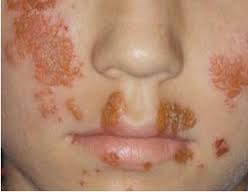pityrosporum folliculitis forehead general guide
1 & 2: Digestive System — Eat less processed or junk food, reduce the amount of fat in your diet, step up water intake and opt for cooling things like cucumbers.
3: Liver —
Cut out the alcohol, greasy food and dairy. This is the zone where food
allergies also show up first, so take a look at your ingredients. Besides all
this, do 30 minutes of light exercise every day and get adequate sleep so your
liver can rest.
4 & 5:
Kidneys — Anything around the eyes (including dark circles) point to
dehydration. Drink up!
6: Heart — folliculitis in nose Check your blood pressure (mine was slightly high) and Vitamin B levels.
Decrease the intake of spicy or pungent food, cut down on meat and get more
fresh air. Besides this, look into ways to lower cholesterol, like replacing
“bad fats” with “good fats” such as Omegas 3 and 6 found in nuts, avocados,
fish and flax seed. Also, since this area is chock-full of dilated pores, check
that your makeup is not past its expiry date or is skin-clogging.
7 & 8:
Kidneys — Again, drink up! And cut down on aerated drinks, coffee and alcohol
as these will cause further dehydration.
Zone 9 &
10: Respiratory system — Do you smoke? Have allergies? This is your problem
area for both. If neither of these is the issue, don’t let your body overheat,
eat more cooling foods, cut down on sugar and get more fresh air. Also keep the
body more alkaline by avoiding foods that make the body acidic (meat, dairy,
alcohol, caffeine, sugar) and adding more alkalizing foods like green veggies
and wheatgrass juice. Another thing that most of forget – dirty cell phones and
pillow cases are two of the top acne culprits and this area is what they affect
the most!
Zone 11
& 12: Hormones — This is the signature zone for stress and hormonal
changes. And while both are sometimes unavoidable, you can decrease their
effect by getting adequate sleep, drinking enough water, eating leafy veggies
and keeping skin scrupulously clean. Another interesting point: breakouts in
this area indicate when you are ovulating (and on which side).
Zone 13:
Stomach — Step up the fibre intake, reduce the toxin overload and drink herbal
teas to help with digestion.
14: Illness
— Zits here can be a sign that your body is fighting bacteria to avoid illness.
Give it a break, take a yoga class, take a nap, take time to breathe deeply,
drink plenty of water and know that everything always works out!
So the next
time you break out or notice pseudofolliculitis barbae, look to your face map:
your skin is probably trying to communicate on behalf of the internal organs.
However, do remember that, as with all medical issues, it is always best to see
your doctor or dermatologist for a proper pityrosporum folliculitis treatment . This is just a general guide
to head you off in the right investigative direction – just because you break
out between the brows doesn’t always mean you have a bad liver!



